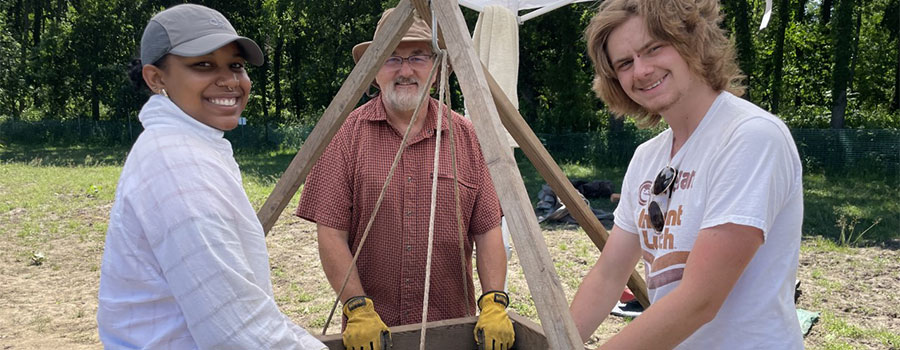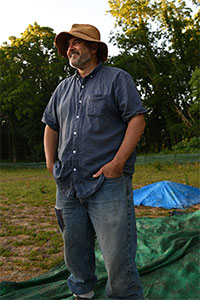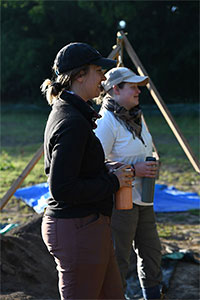
The handful of students arrive for their 6 a.m. class yawning and with coffee in hand, but no one complains about the early start time. The morning air is pleasantly cool, leaves are rustling, birds are chirping, and a deer scampers away when the group passes by.
Deep inside the Cuyahoga Valley National Recreation Area, Dr. Timothy Matney, professor of archaeology, directs the students to begin sifting soil at one of two excavation units. They are at an undisclosed Summit Metro Parks location to learn basic archaeological field techniques, in addition to advanced surveying and recording methods.
The dig site is a hands-on lab for The University of Akron’s (UA) archaeology field school. Undergraduate anthropology and geosciences students from the Buchtel College of Arts and Sciences are conducting archaeological research in collaboration with Summit Metro Parks staff.
Part of UA’s Certificate in Field Archaeology program, the class teaches students basic field methods, how to extract information from the ground, and how to better understand the pre-contact and historic human occupation of the region.
Through this excavation in the Cuyahoga Valley, students are solving real-world problems, said Matney: “It’s mutually beneficial. Our students gain the skills they need to build their careers in archaeology, and they help answer questions the Metro Parks staff have about what cultural materials are located on their properties.
“This area was inhabited thousands of years before Euro-American settlers arrived,” he added. “What’s left of the ancient record is broken up because of modern development, farming and just time. It is slow, painstaking work.”
Answers don’t come quickly like in Hollywood. “UA faculty and students and the Metro Parks staff will be out here for years, slowly trying to piece together the jigsaw puzzle,” said Matney. “When we do find an answer, it is usually not definitive.”
In fact, Summit Metro Parks and UA have worked together on community archaeology projects since 2001. In 2020, the program was revitalized as the Community Archaeology Summer Program (CASP). This particular dig is the second of what could be a five-year project.
Hot Job Prospects

Professor Tim Matney enjoys teaching in the field.
However painstaking it may be, the work will provide a direct path to a job for most of the students, who are in high demand in the Cultural Resource Management (CRM) field, said Matney.
“Federal legislation requires all building projects that use federal funds to assess the impact of their activities on cultural resources such as old buildings and archaeological sites,” he explained. “So every new road construction or oil pipeline that is being built with federal assistance must use part of their budget for a cultural assessment.”
In archaeology, CRM is the industry that provides the expertise to make this assessment, using a variety of surface survey, geophysical survey and excavation techniques to determine the location and significant of historic or ancient places of interest.
“We teach our students these techniques,” Matney added. “The University of Akron program is unique in the region for providing students the specific skill set they need to enter the CRM workforce.”
Alumni Dig In
Maeve Marino, an assistant lecturer in the Department of Anthropology and 2017 graduate, is the site’s field manager. She ensures that students aren’t digging too deep or too fast, and that they are finding actual artifacts, which have minute tell-tale characteristics that distinguish chipped-stone tools from plain rocks.

Maeve Marino (left) and Charlotte Gintert are UA success stories.
In the fall, she will teach a lab methods class, where these students will continue to analyze and interpret the artifacts they are currently finding.
Charlotte Gintert, a 2006 graduate who works as one of two Metro Parks staff archaeologists, said she values the students’ help and labor on this project. “The program really gives students excellent field experience at the undergraduate level, which isn’t common in Ohio. I was very grateful for that and it got me engaged with local archaeology.”
Gintert and Marino serve as invaluable role models for the current group, which includes anthropology students Zoë Brown and Owen Demali—both recipients of the Buchtel College of Arts and Sciences Dean’s Innovation Fund scholarship. A total of nine students are taking the class.
Since each shift can only accommodate six students, an afternoon crew will pick up the tools and shovels after the morning group wraps up.
Never Too Old
One student, Jim Myers, is pursuing his passion for archaeology through UA’s Adult Focus program. In preparation for a trip to the Middle East where he hopes to volunteer on a dig, Myers took an online archaeology class to find out more about where he was going. “I loved the class,” said Myers, “and I found I love archaeology as much as I love history.”
When he took Matney’s introductory class, Myers “caught fire. I love it! Even at my age, I look forward to coming out here every day and doing this. All the students are fantastic.”
And, through finding ancient artifacts, Myers has paused with wonder: “We weren’t here first, were we? To think about how long this stuff has been here—when I am digging I try to think of the person who dropped it—maybe 1700 years ago.”
Having retired from the industrial engineering field when he was 63, he is having the time of his life. “To go back to college now, I feel like a dog with his head joyfully hanging out the window, excited by the trip.”
Myers added, “I like learning and it is just a joy to be here with these students. We all have a passion for digging up the Valley’s secrets.”
